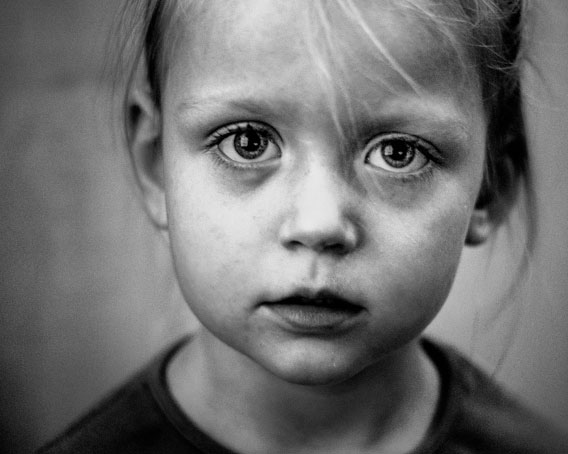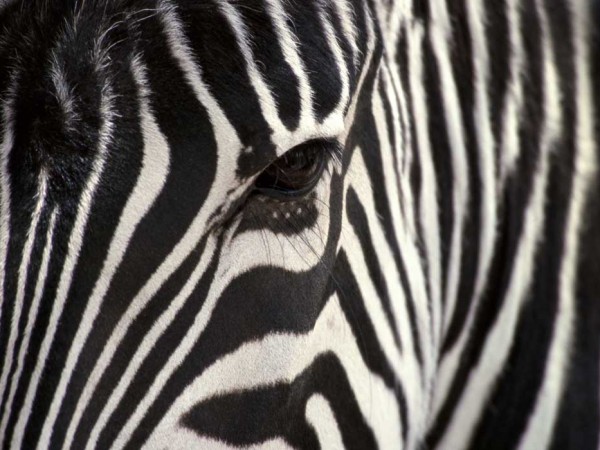Let's begin at the beginning...
What’s the point of a photograph?
Without wishing to be trite, that’s not an easy question to answer. Photographs serve as many things. They can document, explain, illustrate, invoke and they can even be challenging, Mammy [1].

"Carl Brooks" by Max Sparber. © Some rights reserved. Used under Creative Commons BY-NC licence.
So when, the question becomes:
What’s the point of a black & white photograph?
it’s still not an easy question to answer. But there, are lots of good reasons why you might want to shoot in black and white or (just take the easy route and) go black and white in post production. Here are a few:
Black & white images are dramatic.
This is because the contrast between light and dark is emphasised. Shadows appear deeper, highlights appear more vividly.
As a consequence, the image is able to convey its emotional content with more intensity.

"Ronja" by Thomas Nemcseck. © Some rights reserved. Used under Creative Commons BY licence.
Try doing that in glorious Technicolour
Shape, line, form and the spatial relationship between objects become more significant in black & white.
This is because, without the visual cues provided by colour, the viewer is unable to rely so heavily on their own memory or their pre-conception of what an object looks like. Instead, they are forced to look at the object as seen by the camera.

"Balance" by Sam Gabell. © Some rights reserved. Used under Creative Commons BY licence.
Oi, Sisyphus, have you forgotten summ't?
Somehow, black & white images have more gravitas than colour ones do.
They seem more meaningful, more valuable, more like Art.
This is, of course, superficial nonsense, but (and here’s the nub) because they seem that way, they are that way. Photos communicate by conveying feelings, therefore a photo which feels more meaningful, is more meaningful[2].

"Outside World" by Martin Hricko. © Some rights reserved. Used under Creative Commons BY licence.
What if, Harry Potter wasn't a wizard at all? What if, the whole saga, all the stories, are just the fantasies of a small boy, locked in a closet under the stairs, trying to find a way to escape his Aunt & Uncle's abuse? What if, "he who shall not be named" is, actually, the physical act of Harry's abuse? What if, Hogwarts, Dumbledore, Sirrius, Quidditch, the Wands etc. are all simply freudian manifestations of a child struggling to deal with the fear, confusion and guilt of his own sexual awakening after it has been tainted by adult desire? Have I got enough milk? Where's my phone? What if I am, just like, Harry? Oh, look, a cat.
Going colour free can be liberating, because your photos are no longer hostage to its pitfalls.
- Annoying colour casts?
- Unflattering skin tones?
- Noisy images?
All of these issues become much less problematic, if you convert your image to Black & white. In colour, digital “noise” is ugly and distracting. In black & white, it’s “grain” and it’s cool and arty.

"Subway Dancer" by Jaka Koren. © Some rights reserved. Used under Creative Commons BY_NC licence.
Gerald used the time during his daily commute to practice his impression of a flamingo. He was pleased with his progress.
Colour can be a fickle mistress; even pictures taken in the same location in quick succession can suffer significant colour variation. This can be problematic, if you want to use multiple images in a cohesive way, e.g. in a multi-aperture frame.
Pros, expend huge amounts of time, effort and resources, lighting their shots. They don’t do it for fun. They do it because they know that there’s no such thing as a good photograph that is poorly lit.

"Fun Contrast and Light" by Pink Sherbet. © Some rights reserved. Used under Creative Commons BY licence.
Most of us don’t have the luxury of lighting rigs, but if you’re shooting digital, you do have a cheap and easy way of checking the lighting on our photos… just switch the camera into Black and White mode. Dropping the (distracting) colour information from the LCD, makes it much easier to see how the light falls within the shot.
Black & white is one of the cornerstones of photography and developing an understanding of it, playing around with it and using it will help you get the best out of your images.
And, we’re weirdly keen on that.
